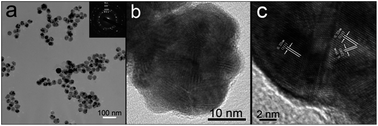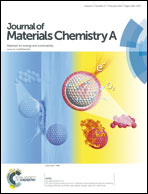Homogeneous Pd nanoparticles produced in direct reactions: green synthesis, formation mechanism and catalysis properties†
Abstract
The direct reactions between ascorbic acid (AA) and palladium salts can produce homogeneous Pd nanoparticles on a large scale by grinding or shaking the two reactants together for ca. 2 minutes at room temperature. The size of homogeneous Pd nanoparticles can be tuned conveniently by using different palladium salts as precursors in the reactions without adding any solvent and organic protectors. Compared to Pd nanoparticles with much smaller sizes of ca. 2.7 nm produced by grinding a solid mixture of AA and Pd(CH3COO)2, homogeneous Pd nanoparticles of 35.6 ± 5 nm can be generated in the direct reaction between AA and Pd(NO3)2·2H2O. It was found that AA can reduce Pd2+ to Pd0 to form Pd nanoparticles directly, accompanied by its oxidation to 2,3-diketogulonic acid (2,3-DKG) and a series of fragment species of 2,3-DKG simultaneously. The small amount of crystalline water in Pd(NO3)2·2H2O can promote the formation of Pd nanoparticles dramatically, compared to the reactions conducted with Pd(CH3COO)2, Pd(NO3)2 and PdCl2 without crystalline water. Based on the experimental results, a two-step reaction mechanism is proposed to understand the formation of Pd nanoparticles. The quasi solid-state features of the direct reactions could lead to defects of high concentration on the surface of the as-prepared Pd nanoparticles, which can be applied to the catalysis of the Suzuki reaction immediately after their formation in the reactions.


 Please wait while we load your content...
Please wait while we load your content...